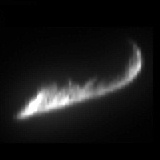 |
|||
|
Artist's impression of NEAR's encounter with the asteroid
Eros.
|
|||
| ASTEROID EROS | |||
| Eros, the son of Mars and Venus, was the Greek god of love. Asteroid 433 Eros was among the first asteroids to be given a male name. It was discovered on August 13th 1898 by Gustav Witt, the head of the Urania Observatory, Berlin. | |||
| Eros was the first Near-Earth asteroid (NEA) to be discovered. Near-Earth asteroids are thought to be material ejected from the main asteroid belt, or dead comets; comets having had their gases depleted by successive approaches to the Sun. | |||
| Orbit | |||
| Eros is in the Amor group of NEAs. It traces an elliptical orbit and is inclined by 10.8o to the plane of the ecliptic. Its closest approach to the Sun is 169 million kilometres and its furthest distance is 266 million kilometres. It takes 1.76 years to move about the Sun, crossing Mars' path but not Earth's. | |||
| However, its perihelion wanders, and at times Eros comes quite close to us. Calculations show that the wandering perihelion gives a 10% chance that Eros will one day collide with Earth. As Eros is larger than the asteroid that hit the Yucatan on Earth 65 million years ago, such a collision would end all human life on this planet. | |||
| In 1975 Eros made its closest 20th century approach to Earth, when it was 22 million kilometres away. In 1901 Eros approached at 48 million kilometres, and in 1931 at 26 million kilometres. The close encounters have enabled astronomers to calculate more accurately the mass of the Earth-Moon system. During the 1975 approach it came under particularly intense scrutiny. It was observed with large telescopes world-wide and remains one of the best studied near-Earth asteroids. | |||
 The orbit of the Earth-approaching asteroid Eros. |
|||
| Physical properties | |||
| Eros is one of just three NEAs over 10 kilometres across. Its dimensions are 33 x 13 x 13 kilometres, making Eros one of the most elongated asteroids known. | |||
| Atmosphere | |||
| No atmosphere has been detected. | |||
| Surface | |||
| Eros was the primary objective of the Near Earth Asteroid Rendezvous (NEAR) spacecraft which was launched in 1996. On its way to Eros, NEAR made a flyby of 253 Mathilde and in 1999 NEAR's first encounter with Eros took place. | |||
 The NEAR spacecraft. |
|||
| During this first flyby, over a thousand images in various wavelengths were acquired. Eros' rapid rotation period (5.27 hours) meant that NEAR could image the entire surface. The best flyby images have a resolution of 400 metres, and revealed much about the surface of Eros in the lead up to the rendezvous. | |||
 Artist's impression of NEAR's encounter with the asteroid Eros. |
|||
| NEAR was placed in orbit of Eros on February 14th, 2000. In a year long programme of mapping and survey using cameras and science instruments (magnetometer, X-ray and gamma-ray spectrometer, infrared spectrometer, multispectral imager, laser rangefinder, and radio science package) NEAR returned thousands of pictures of the surface and data crucial to understanding the asteroid's physical properties. Images and range-finder results have enabled scientists to produce a detailed map and three-demensional model of Eros. | |||
| Early observations of Eros confirmed that it is an S-type or stony-iron asteroid. Its physical properties and spectral characteristics are all consistent with an S-type object. Its density (2500 kg m-3) is slightly lower than might be expected of an S-type, but distinguishes it from C-type (carbonaceous) Mathilde which has a density of just 1.4. | |||
| S-type asteroids contain metals. Earth based observations indicate that they are composed of nickel, iron and contain some magnesium and silicate rocks. The NEAR observations of Eros show that it is compositionally varied and could have formed as part of a planet or asteroid which has a layered or chemically differentiated structure. | |||
 Highest resolution imagery of Eros |
|||
| One side has a higher proportion of olivine, which is a silicate of magnesium or iron. The opposite side (the convex side) has a greater proportion of pyroxene, a silicate which can contain magnesium, iron, calcium, sodium, and aluminium. Both minerals are common in volcanic rocks found on Earth. | |||
 Approach sequence of Eros images obtained by the NEAR spacecraft. |
|||
| S-type or stony-iron asteroids are brighter than C-type asteroids and have albedos of between 0.10 and 0.20. Eros falls in the middle of this range with an albedo of 0.16. Radar measurements indicate that the surface is quite rough, while the thermal properties of the surface suggest that Eros is mantled by a rocky soil. | |||
| The spectacular images NEAR returned reveal an interesting variety of landforms and features. There are many larger craters, some of which have straight sides and are square looking, though there are fewer small craters than expected. Another surprise was the discovery of very many large boulders on the surface, an estimated 1,000,000 being house-size or larger; and there are areas of the surface which appear to have undergone collapse. Scientists are still studying the images to better understand the process at work on Eros. | |||
| The mission finale involved a soft-landing on Eros on February 12th, 2001. During the descent NEAR transmitted 69 images, including very close-up pictures, from just 120 metres above the surface, in which objects just 1cm across are visible. After touchdown, the mission was granted a short extension enabling more surface composition data to be collected using the gamma-ray spectrometer. Eros was a great success and collected ten times more data than originally planned, and its near perfect landing confirming mathematical models for the control of the spacecraft around the highly irregular body. | |||
|
|
|||